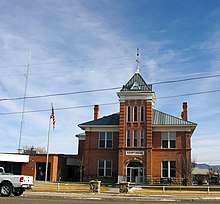Utah State Route 143
| Brian Head-Panguitch Lake Scenic Byway Utah's Patchwork Parkway | ||||
 | ||||
| Route information | ||||
| Maintained by UDOT | ||||
| Length | 51.206 mi[1] (82.408 km) | |||
| Existed | 1933[2]–present | |||
| Tourist routes | ||||
| Major junctions | ||||
| West end | ||||
| East end | ||||
| Location | ||||
| Country | United States | |||
| State | Utah | |||
| Highway system | ||||
| ||||
| ||||
State Route 143 (SR-143) is a
At just over 51 miles (82 km) long, it connects Parowan to Panguitch while providing access to Brian Head, Cedar Breaks National Monument, and Panguitch Lake. It is also the second-highest paved road in the state at 10,626 feet (3,239 m) above sea level.
The western section of the road from Parowan started as a logging road for nineteenth century Mormon pioneers and was designated a state highway in 1933. Twenty years later, the route was extended to Cedar Breaks National Monument, and again in 1985 to its present-day eastern end in Panguitch.
Route description

State Route 143 begins at
As the route climbs onto the

As the highway heads east, it descends through thick aspen forests interspersed with ancient
History
Early roads

The town of
Parowan to Cedar Breaks
State Route 143 was first commissioned in 1933 as the road from
The construction of
In 1975, the construction of I-15 was complete, including a second Parowan interchange that had not been in the original plans. This interchange was located west of Parowan, between the Summit interchange to the southwest, and the Parowan interchange to the north. In response, the legislature rerouted SR-143 to connect to the west interchange. Instead of turning north on Main Street, SR-143 now turned south on Main Street for two blocks (coinciding with SR-38) and turned west to reach the new interchange. The two blocks of Main Street overlapping SR-38 were transferred to SR-143, with the remainder of that route deleted and withdrawn from the state highway system. The former route of SR-143 northerly through Parowan was re-designated
Cedar Breaks to Panguitch

The other end of SR-143 has undergone route changes as well. Prior to 1969,
In 1985, the southern portion of SR-143 between SR-14 and the southern Cedar Breaks National Monument boundary was re-designated
The route was designated as a
Major intersections
| County | Location | mi[1] | km | Destinations | Notes |
|---|---|---|---|---|---|
I-15 BL – Cedar City, Beaver | Western terminus, also Exit 75 on I-15; western terminus of BL-15 overlap | ||||
| 2.651 | 4.266 | I-15 BL (Main Street) | East end of BL-15 overlap | ||
| | 10.083 | 16.227 | Dry Lakes Road Scenic Backway | ||
Cedar Breaks Scenic Byway ) | |||||
| Garfield | Panguitch | 51.206 | 82.408 | Eastern terminus | |
1.000 mi = 1.609 km; 1.000 km = 0.621 mi
| |||||
References
- ^ . December 2008. Retrieved July 15, 2009.
- ^ . November 2008. Retrieved July 15, 2009.
- ^ a b c Google (July 20, 2009). "Utah State Route 143" (Map). Google Maps. Google. Retrieved July 20, 2009.
- ^ a b c d e "Scenic Byways and Backways". Cedar City/Brian Head Tourism Bureau. Retrieved July 20, 2009.
- ^ a b "Pioneer History and Scenery on Utah's Patchwork Parkway". Federal Highway Administration. Retrieved July 20, 2009.
- ^ a b "Brian Head-Panguitch Lake Scenic Byway". Utah Travel Industry. Retrieved July 20, 2009.
- ^ a b "Utah's Patchwork Parkway Scenic Byway Corridor Management Plan, Chapter 10 - Scenic" (PDF). Scenic Byway 143 National Designation Steering Committee. Retrieved July 20, 2009.
- ^ Arave, Lynn (March 22, 2007). "Enjoy Utah's scenic heights from your car". Deseret News. Salt Lake City, Utah. Retrieved July 15, 2009.
UDOT agrees that state Route 143, the segment by Cedar Breaks National Monument, is the state's second-highest paved road. It reaches 10,626 feet above sea level.
- ^ "Panguitch Visitor Information". City of Panguitch, Utah. Retrieved August 7, 2009.
- ISBN 978-0-12-088253-3.
- ISBN 978-0-471-33218-3.
- ^ a b "Utah's Patchwork Parkway Scenic Byway Corridor Management Plan, Chapter 5 - Archeological" (PDF). Scenic Byway 143 National Designation Steering Committee. Retrieved July 26, 2009.
- ^ a b "Utah's Patchwork Parkway Scenic Byway Corridor Management Plan, Chapter 7 - Historical" (PDF). Scenic Byway 143 National Designation Steering Committee. Retrieved July 26, 2009.
- ^ a b Hinton, Wayne K.; Powell, Allen Kent (1994). "Cedar Breaks National Monument". Utah History Encyclopedia. University of Utah: University Press. Retrieved July 26, 2009.
- . May 2008. Retrieved July 15, 2009.
- . November 2008. Retrieved July 15, 2009.
- ^ "Utah's Patchwork Parkway (U-143) - Official Designations". Federal Highway Administration. Retrieved July 15, 2009.
- ^ "Scenic Byway 143". Iron County. Retrieved July 15, 2009.
External links
 Media related to Utah State Route 143 at Wikimedia Commons
Media related to Utah State Route 143 at Wikimedia Commons

